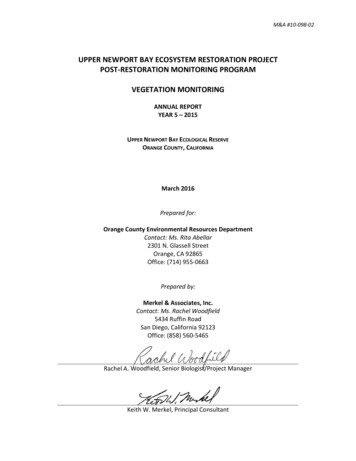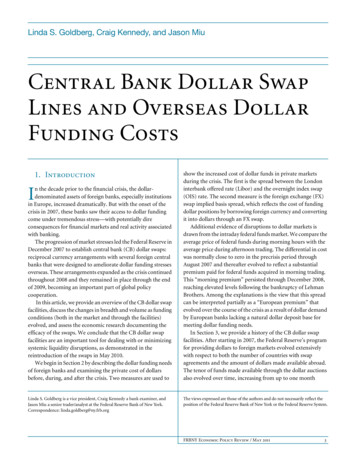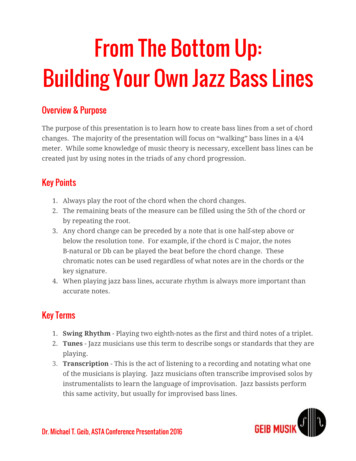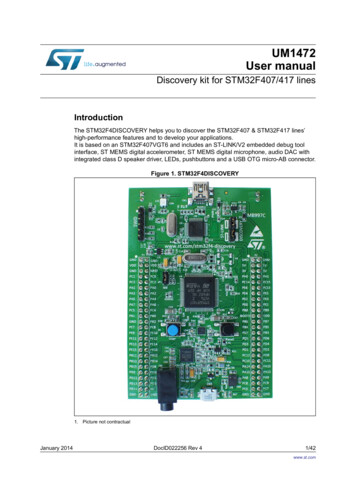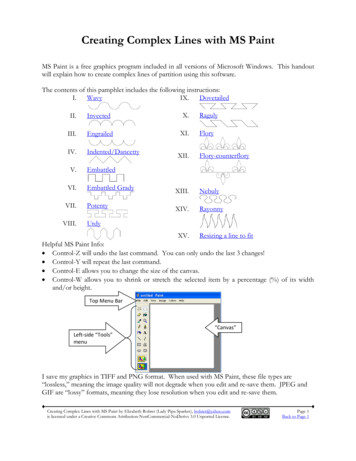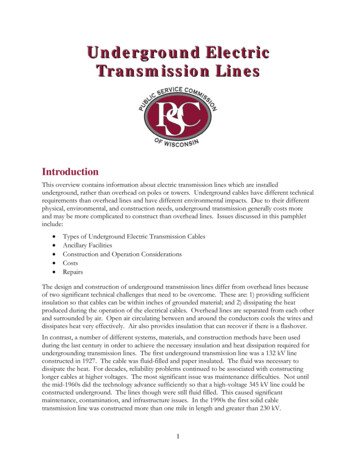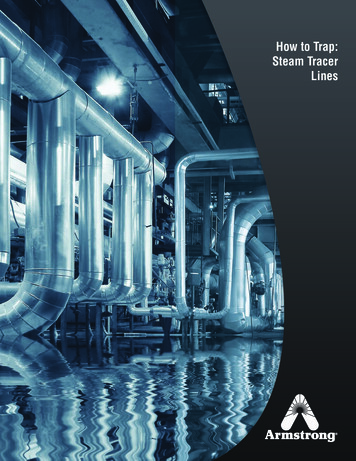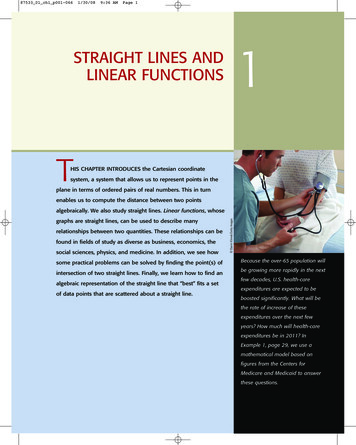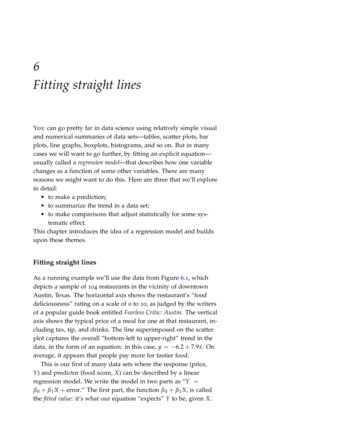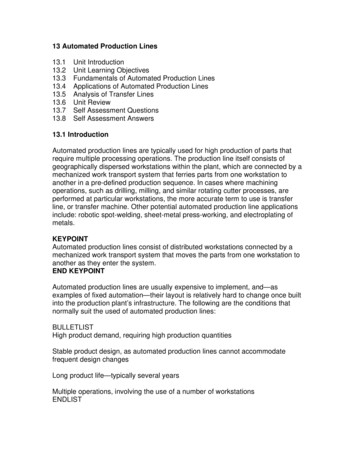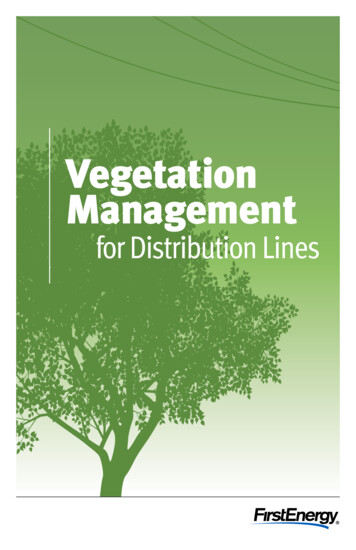
Transcription
VegetationManagementfor Distribution Lines
WorkingHand in Handwith NatureTrees contacting power lines and other electricfacilities are the major cause of electric serviceinterruptions, especially during severe weather.To prevent interruptions to your electric service,FirstEnergy has a year-round vegetationmanagement program aimed at keepingnearly 280,000 miles of lines in our six-state,65,000-square-mile service territory clear oftrees and undergrowth.In 2018, FirstEnergy was recognized for the 20thconsecutive year as a Tree Line USA utility by theNational Arbor Day Foundation in cooperationwith the National Association of State Foresters.The award recognizes utilities that promote thedual goals of dependable utility service andabundant, healthy trees along America’s streetsand highways. Award-winning companiesdemonstrate excellence in tree care, trainingand public education.2
What are Distribution Lines?Electrical distribution lines are underground or overhead power lines thatcarry electricity from a substation to your home. Overhead lines are typically visiblethroughout your neighborhood, extending from pole to pole. Occasionally treesor other types of vegetation can interfere with these lines and it is important tomanage this before it affects your electric service.Why is Tree Pruning Necessary?Trees can threaten service reliabilityTrees interfering with power lines can cause two different types of outages.1. A momentary power interruption – When a tree limb contacts a power line,the tree becomes an alternative path for the electricity, which creates a shortcircuit. Small branches and twigs often clear from the line before a strong pathto ground is established. The result is a momentary power interruption thatlasts just long enough to cause your lights to blink. However, when many twigsand branches are in contact with a line, the cumulative effect can be enough tocause a complete loss of power.2. A complete loss of power — Lightning, wind or the weight of ice and snow can snaptree branches and topple them into power lines. Trees and tree limbs weakened byage, disease or insects can also break and damage power lines. This results in asustained interruption that requires repairs to the line.Trees can threaten public safetyWhen trees impact electric lines and cause power outages, it’s more than inconvenient. Such situations can also threaten public safety, especially when they involve fallenwires or when service is interrupted to hospitals, nursing homes, traffic light controls,water pumps, fire alarms and other vital facilities. Never go near a downed wire and warnothers to stay away. If you see a downed line, stay at least 30 feet away and call 911immediately to report it.Pruning IntervalsAlthough it is not possible to predict all tree-related problems, FirstEnergy’s tree-pruningprogram is designed to prevent safety or reliability problems from occurring. Typically, weprune trees on a maintenance cycle every four or five years. We also review records of powerinterruptions attributed to trees to help establish our tree-pruning priorities.3
Professional Utility Tree Workers Help Keep the Lines ClearFirstEnergy employs independent contractors whose skilled, professional utilitytree crews prune trees to provide enough clearance between limbs and lines for safeand reliable service. Utility tree crews perform the work, following ANSI A300 pruningstandards, under the guidance and inspection of FirstEnergy’s professional utilityforestry staff.Drop-crotch cutWe encourage our contractors to use naturalpruning methods such as drop-crotch or directionalpruning, proven to be the best method for the long-termhealth of the tree. It is called drop-crotch pruningbecause the proper cut for the best health of the tree isat the crotch of the branch where it joins a larger branchor trunk. It is also known as directional pruning becauseit directs subsequent growth away from the power lines.This type of pruning reduces the amount of wood to beremoved in future trims.Remove thisCut hereKeep thisWhen Pruning Isn’t EnoughOccasionally, trees are planted in unsuitable areas. Some trees belong in the forest,not in an urban environment. For fast-growing trees like silver maples, willows andsycamores, the repeated prunings required to keep limbs clear of power lines increasetree decay and make trees more susceptible to disease. When these types of trees areplaced directly under or near power lines, removal is the best solution.Wood Disposal and Stump RemovalGenerally, utility tree crews do not remove stumps or roots of trees, althoughthis service may be available at a minimal cost to property owners in some areas.In most cases, stumps will be cut off flush with the ground. Trees that are locatedin fencerows or that contain metal, cement, rocks, etc., will be cut above theinterfering material.After a tree is pruned or removed, small tree limbs and branches are disposedof in a manner that is acceptable to the landowner and FirstEnergy. Wood that istoo large for the chipper is cut into manageable lengths, or as otherwise describedin the tree removal agreement, and left on the property near the base of the tree.Disposal or use of all such wood is the property owner’s responsibility.4
Customer Notification is ImportantIn most cases, we will attempt to notify the property owner before removing a tree.However, in an emergency, we are not always able to contact the property owner inadvance. If the tree in question is located between utility poles, a Forestry representativewill determine if FirstEnergy will remove the tree. Where trees are located betweena utility pole and the customer’s home, we will disconnect the service, but in mostcases the homeowner will be responsible for the actual tree removal. Please call yourFirstEnergy utility for specific details about your tree and power lines.Proper Tree PlacementTree management around power lines requires a long-term perspective. The conflictbetween trees and power lines can be resolved through timely, effective pruning andalso by making sure that the right trees are planted in the proper place.Our professional forestry staff recognize that each tree has its own uniquecharacteristics. While many trees contribute greatly to our living environment, othersdon’t do well in certain areas. Tall-growing trees are not compatible with electric lines.Areas around distribution power lines have only 25 feet of growing room for tree height,so it does not make good sense to plant trees that will grow 80 feet tall in such a place.We prefer that you avoid planting any tree underneath power lines, but if you dothe key is to select the right kind of tree for the location. As the diagram shows, makesure any tree planted within 20 feet of neighborhood distribution power lines is avariety that will grow to a mature height of 25 feet or less. Small trees such as floweringcrabapple, dogwood or serviceberry are ideal for these locations. In addition, such treesoften feature smaller root structures. So they’re also less likely to crack sidewalks anddriveways or to clog underground drain lines.(continued on next page)5
Proper Tree Placement (continued from previous page)Plant taller trees farther away to ensure they can’t grow into power lines. Atdistances of 20 to 50 feet, plant trees that grow to a height of 40 feet or less. Forinstance, linden or magnolia trees are a good choice in these areas.If you want to plant a tree that grows tall, such as a maple, oak, pine or spruce,make sure it’s at least 50 feet from the nearest residential overhead lines.There are a number of tree varieties that are specifically not recommended foruse near overhead lines of any kind. The disadvantages of these trees include brittleness– which makes them vulnerable to storm damage – or susceptibility to disease andinsect infestations.Trees to avoid for these reasons include:Black LocustCallery PearCatalpaBox ElderElm – AmericanElm – SiberianHorse chestnutMulberryPoplar (Carolina, Lombardi or other hybrids)Silver MapleSycamoreTree-of-HeavenWhite PineWillowUnderground Electric ServiceDo not plant trees and shrubs too close to underground lines. Trees with shallowsurface roots or deep spreading roots can damage them. Special care also should betaken when planting near above-ground pad mount transformers. Please plant treesand shrubs at least 10 feetaway from a transformer’srformeTrans ont3’Frservice door, and at leastthree feet from its backand sides. Remember toconsider the plants mature3’3’width prior to spotting10’the location.6
Transmission Lines and Rights-of-WayVegetation around transmission lines is treated much differently thanvegetation around distribution lines. When site conditions permit, FirstEnergyutilizes the “wire zone-border zone” approach to perform vegetation maintenanceon the actively maintained right-of-way. All trees and incompatible vegetation areremoved and controlled in both zones. In the “wire zone,” which extends about15 feet beyond each side of where the wires are attached to tower or structure,efforts are made to encourage a low growing plant community of grasses, herbs,and shrubs that mature at less than five feet tall. In the “border zone,” whichextends beyond the wires to the edge of the ROW, a plant community of forbs andtaller compatible shrubs that mature at 15 feet or less may be allowed to growdepending on site conditions.OFF-ROWBorderZoneWire ZoneBorderZoneOFF-ROWWire ZoneDirectly under the wires andextending 15’ on each side ofoutside conductorBorder Zone15’ from each outside conductor to the edgeof the transmission corridorWe also inspect the areas beyond the ROW. Trees that are dead, dying,diseased, structurally defective, leaning or significantly encroaching may beremoved if they are determined to pose a danger of arcing or falling into thetransmission line or facilities.If you are considering planting shrubs on any transmission right-of-way, pleasecontact our utility forestry staff for information.7
Call Before You DigBefore you plant trees or shrubs, dial 8-1-1. This federallymandated national “Call Before You Dig” number was created tohelp protect you from unintentionally hitting underground utilitylines. Call at least three days prior to starting your project to haveyour lines marked so you can dig safely.The Big PictureWe take our job of providing reliable and safe electricity to your home andcommunity very seriously. One tree-related outage can affect hundreds of customers.We appreciate your cooperation in supporting our vegetation management program.By working together, we can hold down the cost of your electric service, reduce thepossibility of power interruptions to your neighborhood, and still enjoy the positivequalities that trees contribute to our lives.If you have any questions about our vegetation management program, please visitwww.firstenergycorp.com/trees or call your FirstEnergy electric utility.The Illuminating Company . . . 1-800-589-3101JCP&L . . . . . . . . . . . . . . . . . . . . 1-800-662-3115Met-Ed . . . . . . . . . . . . . . . . . . . 1-800-545-7741Mon Power . . . . . . . . . . . . . . . . 1-800-686-0022Ohio Edison . . . . . . . . . . . . . . . 1-800-633-4766Penelec . . . . . . . . . . . . . . . . . . . 1-800-545-7741Penn Power . . . . . . . . . . . . . . . 1-800-720-3600Potomac Edison . . . . . . . . . . . 1-800-686-0011Toledo Edison . . . . . . . . . . . . . 1-800-447-3333West Penn Power . . . . . . . . . . 1-800-686-0021This brochure is provided for informational purposes only. Vegetation managementprograms require a structure that allows flexibility in order to accommodate eachsituation’s unique characteristics, so specific work plans may vary.FORM 1077 (REV.09-2020) ID NO. 100005673COMM2125-09-20-CV-DPProduced by FirstEnergy’s Communications and Branding Department
There are a number of tree varieties that are specifically not recommended for use near overhead lines of any kind. The disadvantages of these trees include brittleness – which makes them vulnerable to storm damage – or susceptibility to disease and insect infestations. Trees to avoid for
